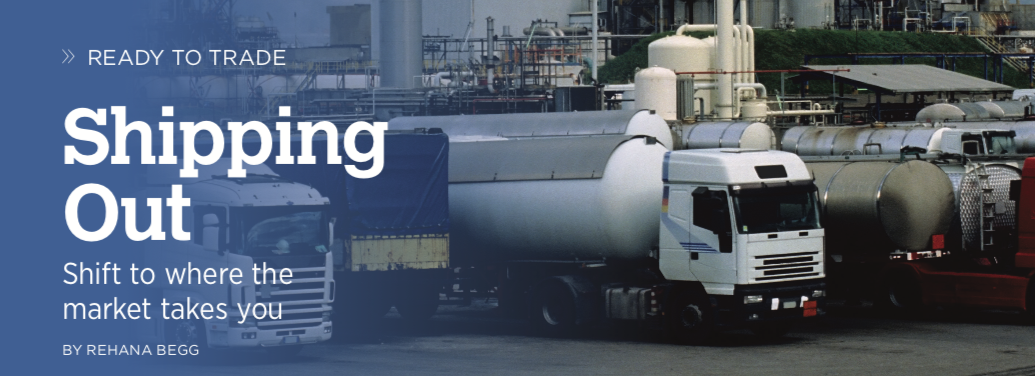
Ready to trade? Shift to where the market takes you
Rehana Begg

Dennis Dussin, president of Alps Welding demystifies trade misconceptions, and makes a case for clean technology
 For the past 45 years, Alps Welding has provided custom fabrication services to North America’s largest design engineers, equipment designers, and plant operators. The Woodbridge, Ont.-based manufacturer of pressure vessels, piping systems, heat exchangers, and other custom process equipment, has watched the market evolve as food and chemical companies closed down their Toronto-area plants, only to move to the outskirts or further afield to the U.S. The market shift effectively compelled Alps to transform its operations to becoming a manufacturer of equipment that can be shipped. With Toronto representing a very small part of its revenue today, Alps looks to Western Canada and the U.S. to keep growing.
For the past 45 years, Alps Welding has provided custom fabrication services to North America’s largest design engineers, equipment designers, and plant operators. The Woodbridge, Ont.-based manufacturer of pressure vessels, piping systems, heat exchangers, and other custom process equipment, has watched the market evolve as food and chemical companies closed down their Toronto-area plants, only to move to the outskirts or further afield to the U.S. The market shift effectively compelled Alps to transform its operations to becoming a manufacturer of equipment that can be shipped. With Toronto representing a very small part of its revenue today, Alps looks to Western Canada and the U.S. to keep growing.
CanadianManufacturing.com interviewed Dennis Dussin, president of Alps Welding, for the Export Insights 2019 report. In this edited Q&A, Dussin explains how the company is transforming the business, demystifying trade misconceptions, and making a case for clean technology.
What was the rationale for including the U.S. as a key market?

PHOTO: Dennis Dussin, Alps Welding
Dennis Dussin: It really was the proximity. The equipment that we build is large and heavy, so transportation is a factor and a cost. We’re more competitive in markets that are closer, but pretty much everything we build is shipped by road. Having markets that we can access by road is critical. Essentially, that’s to the U.S. That’s not to say we don’t ship globally—we have equipment in projects all over the world—but it’s a smaller part of the business.
How do you go about researching a new market for opportunities?
Dussin: We’re in a lot of different sectors. We build equipment for oil and gas, chemical, mining, power generation….The research we’re doing is looking for companies that are making big investments, such as a company that’s expanding a refinery, or a new resource development project. We look at where those projects are and that forms the basis of our research. We look at the engineering company that’s looking after that project and [figure out] whether we have any contacts or referrals to get into those relationships.
What percentage of your business is exporting?
Dussin: About half of our business is exporting. The lion’s share of that is to the U.S. Our reach is across the U.S., across California, and down in the Gulf, including Louisiana, Texas, and Oklahoma. The other area is Europe. We’ve had projects and partnerships with European companies that are executing projects in North America, and that were looking for a manufacturing partner in North America. We would consider that a sale to a European customer, even though the project is still in the U.S. We’ve done a couple of projects in Central America as well.
How do customs and regulatory requirements impact your production?
Dussin: It’s generally a non-issue. Because we ship so much equipment to the U.S., we are well-versed in the documentation that’s required. We have a good customs broker that assists us. However, in the past 12 to 18 months, with the steel tariffs, it has become more of an issue. But costs come into play mostly on material coming in or when we’re importing. Tariffs haven’t applied to products we’re shipping. There may be some customers who are skeptical of doing business in Canada because they worry about customs and border control issues, but we tell them that because we have the knowledge to export from Canada, we make the border transparent and make it a non-issue for them—we handle all of that.
What are the biggest misconceptions about providing large custom fabrication services to North American clients?
Dussin: One of the misconceptions is that because the equipment is large, one needs to procure it really close to the site. Some of our American customers say, “How can you be competitive if you’re in Toronto and we need that equipment in California? It’s too far.” I tell them transportation and logistics are not that complicated; there are excellent logistics and trucking companies that we use and partner with that solve a lot of problems. The cost of shipping a big vessel from Toronto to California is not that much in the context of the total value of that vessel or [piece of] equipment.
Another misconception is, because we’re in Canada, we might not understand the specifications, regulatory, and health and safety requirements because we’re in a different jurisdiction. That’s a false reading because we do so much business in the U.S., and we’re very familiar with its regulations and requirements, so that’s not a big problem.
Related:
Download the Export Insights 2019 report for an analysis of Canadian trade and exports
Would companies starting out need staff on the ground in the foreign country?
Dussin: No, I don’t think so. There are different standards. In the U.S., there’s the AWS—the American Welding Society. And we have the CWB—the Canadian Welding Bureau. It does take a little bit of work to make sure you’re in compliance with the standards, but it’s not rocket science. There are good resources at the CWB to help you navigate. We’ve done business in the U.S. for many years and haven’t needed people on the ground in the U.S. We’ve been able to do that from Canada. I don’t think it’s something that should hold companies back.
Are you planning to adjust your exporting strategy because of geopolitical factors?
Dussin: We have good relationships with our U.S. customers. Regardless of what happens with geopolitics, it hasn’t really impacted our relationships. I think our American customers are committed to having us in their supply chain because of the value we provide. It has made things a little more complicated and maybe we want to talk about things that we didn’t have to talk about, but it hasn’t really changed our relationship even through the whole unravelling of NAFTA….So what does that mean for the future? We always have market diversification on our mind. We try to be diversified in terms of industries we serve [and] in terms of geography, but it has highlighted the fact that, as a company, we’re very dependent on the U.S. as an export market. Should something happen, it will be a major problem for us. It made us think: Can we grow our business in Europe, South America, Central America? We’re looking at those things but definitely not at the expense of our U.S. exports. Business continues to be strong.
What do you want to accomplish over the next few years?
Dussin: A big part of our strategy going to market in the next few years is really around clean technology. A lot of our customers are in oil and gas or chemical or steel making. They face environmental challenges. A lot of what’s driving our investments in equipment is around improving the environmental performance of somebody’s facilities.
The three things are controlling emissions (CO2 and other emissions), saving water (water treatment and conservation), and saving energy (heat exchangers, condensers and economizers). Our customers are all investing in those things. What we see in our strategy is becoming a vendor of those kinds of technologies. We partner not only with the end users—our customers include companies like Chevron and Suncor and ConocoPhillips—but more and more we’re seeing our customers as the engineering companies that design those environmental technologies. They design emission-control equipment or heat exchangers, and they need a manufacturer that can build the equipment in compliance with the specifications of Chevron or Suncor or ConocoPhillips, which we’re very well versed in. I think Canada is particularly well positioned to become an exporter in clean technology. Our strategy is to be a part of that.
A good piece of advice is…
Dussin: A real transformation in our business has come from getting involved with other business groups. Joining the CME—Canadian Manufacturers and Exporters—opened our eyes to best practices that other manufacturers are engaging in. Joining an organization like the CME allows you to learn from other companies. Get out and do lots of shop tours, either in your industry or in other industries. To compete outside of your local area, you really have to incorporate best practices. It’s lean manufacturing, it’s the best sales and marketing, it’s leveraging the latest technology….And all of these ideas are going to come from outside your company, from associations and plant tours you take. And, if you’re competing in your local market, you have to be the best, say, in the Toronto area. But if you want to compete across North America, then you have to be the best in North America. You have to be as good as everybody in California, Texas, and Alberta. Be open to ideas from outside your company, and be ready to change and improve and adopt best practices.
Rehana Begg is the editor of CanadianManufacturing.com. Reach her at rbegg@annexbusinessmedia.com.
This article was first published in Export Insights 2019 as “Shipping Out – Shift to where the market takes you.”